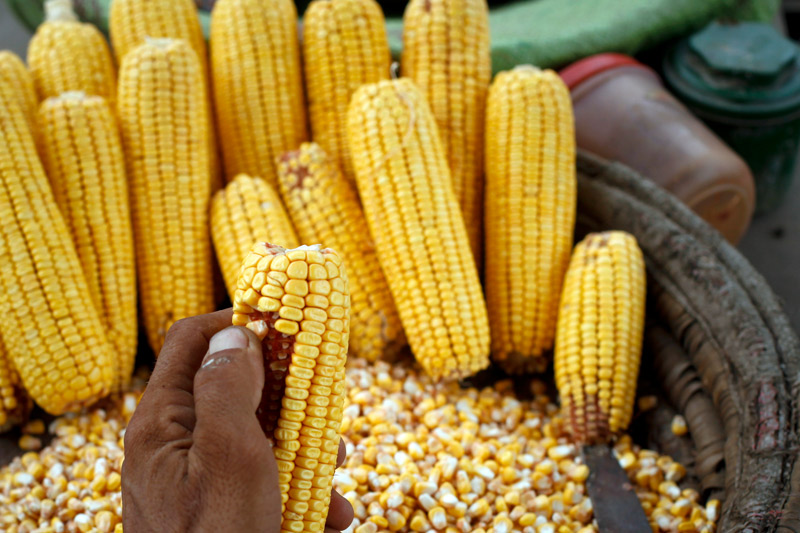Investing.com - U.S. grain futures were broadly lower during European morning hours on Thursday, with soybean and corn prices trading at the lowest level since mid-July amid easing fears over the pace of the U.S. harvest.
Grain traders also readjusted positions ahead of the U.S. Department of Agriculture’s quarterly report on grain inventories, due Friday.
On the Chicago Mercantile Exchange, corn futures for December delivery traded at USD7.2162 a bushel, shedding 0.35%.
The December contract fell by as much as 0.5% earlier to hit a session low of USD7.2138 a bushel, the weakest level since July 12.
Corn prices have been under pressure in recent weeks, after data showed the U.S. corn harvest was accelerating at a faster rate than anticipated.
Nearly 39% of the U.S. corn crop was harv6ested as of last week, up from 26% in the preceding week and significantly higher than the 12% recorded in the same week a year earlier.
Corn prices touched a record high of USD8.4237 a bushel on August 10, as escalating concerns over the impact of the worst drought in at least 56 years in the U.S. Midwest and Great Plains-region drove prices higher.
Meanwhile, soybeans futures for November delivery traded at USD15.6925 a bushel, dropping 0.25%. The November contract fell by as much as 0.45% earlier in the session to hit a daily low of USD15.6888 a bushel.
November soybean futures touched an 11-week low of USD15.6512 a bushel on Wednesday.
Soybean prices have been under heavy selling pressure in recent sessions, losing nearly 12% since hitting an all-time high of USD17.8888 a bushel on September 4, as U.S. farmers started harvesting soybeans at a brisk pace.
Approximately 22% of the U.S. soy crop was harvested as of September 23, compared to just 4% harvested in the same week a year earlier. The five-year average for this time of year is 8%.
Elsewhere, wheat for December delivery traded at USD8.6725 a bushel, shedding 0.3%. Earlier in the day, prices fell by as much as 0.6% to hit a session low of USD8.6588 a bushel, the weakest level since September 18.
Market participants continued to monitor developments out of Russia, amid fears the country could limit grain exports in the autumn if domestic grain prices rise sharply.
In 2010, Russia barred grain exports for almost a year amid a severe drought, prompting global buyers to turn to U.S. supplies.
Russia is a major wheat exporter and competes with the U.S. for business on the global market. A disruption to exports from the country could boost demand for U.S. supplies, which is the world’s third largest wheat producer and biggest exporter.
Corn is the biggest U.S. crop, valued at USD66.7 billion in 2010, followed by soybeans at USD38.9 billion, government figures show. Wheat was fourth at USD13 billion, behind hay.
Grain traders also readjusted positions ahead of the U.S. Department of Agriculture’s quarterly report on grain inventories, due Friday.
On the Chicago Mercantile Exchange, corn futures for December delivery traded at USD7.2162 a bushel, shedding 0.35%.
The December contract fell by as much as 0.5% earlier to hit a session low of USD7.2138 a bushel, the weakest level since July 12.
Corn prices have been under pressure in recent weeks, after data showed the U.S. corn harvest was accelerating at a faster rate than anticipated.
Nearly 39% of the U.S. corn crop was harv6ested as of last week, up from 26% in the preceding week and significantly higher than the 12% recorded in the same week a year earlier.
Corn prices touched a record high of USD8.4237 a bushel on August 10, as escalating concerns over the impact of the worst drought in at least 56 years in the U.S. Midwest and Great Plains-region drove prices higher.
Meanwhile, soybeans futures for November delivery traded at USD15.6925 a bushel, dropping 0.25%. The November contract fell by as much as 0.45% earlier in the session to hit a daily low of USD15.6888 a bushel.
November soybean futures touched an 11-week low of USD15.6512 a bushel on Wednesday.
Soybean prices have been under heavy selling pressure in recent sessions, losing nearly 12% since hitting an all-time high of USD17.8888 a bushel on September 4, as U.S. farmers started harvesting soybeans at a brisk pace.
Approximately 22% of the U.S. soy crop was harvested as of September 23, compared to just 4% harvested in the same week a year earlier. The five-year average for this time of year is 8%.
Elsewhere, wheat for December delivery traded at USD8.6725 a bushel, shedding 0.3%. Earlier in the day, prices fell by as much as 0.6% to hit a session low of USD8.6588 a bushel, the weakest level since September 18.
Market participants continued to monitor developments out of Russia, amid fears the country could limit grain exports in the autumn if domestic grain prices rise sharply.
In 2010, Russia barred grain exports for almost a year amid a severe drought, prompting global buyers to turn to U.S. supplies.
Russia is a major wheat exporter and competes with the U.S. for business on the global market. A disruption to exports from the country could boost demand for U.S. supplies, which is the world’s third largest wheat producer and biggest exporter.
Corn is the biggest U.S. crop, valued at USD66.7 billion in 2010, followed by soybeans at USD38.9 billion, government figures show. Wheat was fourth at USD13 billion, behind hay.
